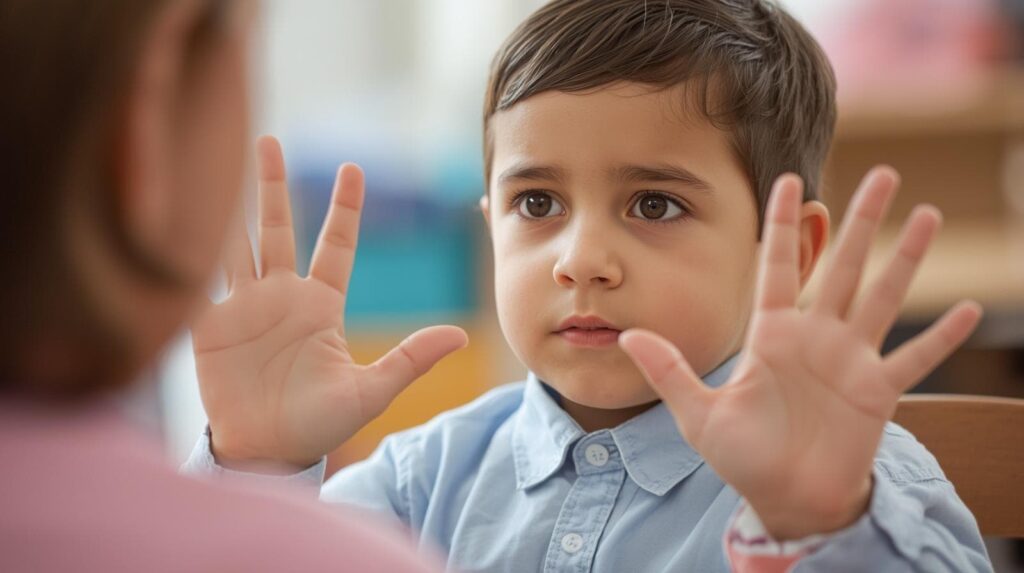
Key Points:
- Nonverbal autism refers to individuals on the autism spectrum who do not reliably use spoken language, though they may communicate in other ways.
- Recognizing nonverbal autism signs means looking beyond lack of speech. Look for limited gestures, poor eye contact, delayed social reciprocity, sensory sensitivities, and repetitive behaviors.
- Diagnosis is based on behavioral observation, standardized tools (e.g. ADOS-2, VB-MAPP), rule-outs (hearing, medical causes), and ongoing monitoring.
- Early intervention, especially via evidence-based therapies like ABA with augmentative communication systems, can improve communication and quality of life.
For many parents and caregivers, noticing that a child isn’t speaking when expected triggers worry. When that child has been evaluated and is found to have autism, the term nonverbal autism may come up. But what exactly does nonverbal autism mean, and how can you tell if it applies to your child? In this article, we’ll explore nonverbal autism signs, how clinicians approach diagnosis, and what you can do next. The goal is to equip you with clear, specific information so you can seek help with confidence and understand how support can begin right away.
What “Nonverbal Autism” Means
The phrase nonverbal autism (also sometimes called nonspeaking or minimally verbal autism) is not a separate, standalone diagnosis. Rather, it describes a subset of individuals on the autism spectrum who do not reliably speak in a functional way.
Here are some important clarifications:
- Not the same as no communication at all. A nonverbal child often uses other means – writing, gestures, pointing, facial expressions, communication devices, to express needs or thoughts.
- It doesn’t always indicate low cognitive ability. The absence of spoken language does not necessarily reflect a lack of understanding or intelligence.
- Some individuals are minimally verbal, meaning they use a very limited vocabulary of spoken words (a few words or phrases) but not a full language system.
- Over time, some nonverbal individuals may develop functional speech; others may continue using alternative communication systems.
Because nonverbal autism exists on a continuum, recognizing it early and tailoring support matters greatly.

Recognizing Signs: What to Watch For
Because speech is just one form of communication, detecting nonverbal autism signs requires observing many domains of behavior and interaction. Below are specific signs categorized by developmental stage and domain.
Early Indicators (Infants and Toddlers)
Here are red flags before age 2-3 that may suggest nonverbal autism:
- Lack of babbling or early vocalization – by 6-12 months, most infants babble or make cooing noises. A child who remains silent, produces few sounds, or stops babbling may warrant attention.
- Limited or no use of gestures – not pointing, waving, or reaching out by 12–14 months.
- Delayed or absent eye contact – not looking at caregivers, avoiding gaze, or seeming uninterested in faces.
- Not responding to name or environmental cues – by about 12 months, many children respond when their name is called; irregular response may be a signal.
- Reduced social reciprocity – not engaging in back-and-forth play, not showing or sharing objects of interest, limited social smiling.
- Sensory over- or under-reactivity – seeming indifferent to loud noises or extremely distressed by everyday sounds, textures, or lights.
- Repetitive movements or interests – hand flapping, rocking, spinning, or insistence on sameness even at a very young age.
These signs do not automatically mean nonverbal autism; they are signals that further evaluation may be needed.
Signs in Older Children
When speech is more expected (ages 3+), these signs may emerge:
- No functional spontaneous speech – the child does not combine words or use them to communicate wants, needs, or ideas.
- Use of vocalizations or sounds instead of words – effortful noises, squeals, or unintelligible utterances used as communication.
- Minimal phrase speech – perhaps a few words or short phrases, but not consistent, flexible use of language.
- Lack of gesture-speech pairing – for example, not pointing while asking, not shaking head “no” while refusing, not nodding “yes.”
- Difficulty with nonverbal cues – struggle interpreting gestures, facial expressions, body language of others.
- Rigid routines and resistance to change – distress if schedules shift slightly, insistence on sameness across contexts.
- Restricted or fixated interests – a deep focus on specific objects or themes, less flexible play.
- Self-regulation challenges – meltdowns, shutdowns, or self-soothing repetitive motions under stress.
Communication Behaviors (Compensatory Signs)
Because spoken language may not develop, many individuals with nonverbal autism use these strategies:
- Pointing, leading, or pulling a hand to indicate desire
- Gesture systems or sign language
- Augmentative and Alternative Communication (AAC) – e.g. picture exchange cards (PECS), speech-generating devices, apps
- Writing, typing, or spelling – some nonspeaking persons communicate via text or keyboards
- Vocal approximations or idiosyncratic sounds that caregivers may learn to interpret
Observing a combination of the above signs increases the clarity of the picture. A single sign in isolation is insufficient for diagnosis.
How Nonverbal Autism Is Diagnosed
Diagnosing nonverbal autism is complex because there’s no medical test or biomarker. Instead, the process is clinical and observation-based. Here’s how professionals approach it.
Step 1: Rule Out Other Causes
Before attributing non-speech to autism, clinicians typically check:
- Hearing evaluation – to ensure hearing loss or auditory impairments aren’t causing the speech absence
- Medical and neurological assessment – to detect underlying conditions (e.g. seizure disorder, brain injury)
- Oral-motor evaluation – to identify physical issues affecting speech articulation
- Developmental history and growth – to check for language regression or plateau
Ruling out these causes helps ensure the accuracy of the autism-related interpretation.
Step 2: Developmental & Behavioral Evaluation
- Standardized autism assessments: Instruments like the Autism Diagnostic Observation Schedule (ADOS-2) adapted for minimal verbal children are used.
- Curriculum-based assessment: Tools such as the Verbal Behavior Milestones Assessment and Placement Program (VB-MAPP) help break down language and social milestones for children with limited speech.
- Parent interviews & history: Clinicians gather detailed accounts of developmental milestones, regression, communication attempts, and behavioral signs
- Direct observational data: Clinicians examine how the child interacts, responds to attempts to communicate, uses gestures or AAC, and their level of social engagement
- Standard checklists and rating scales: E.g. Gilliam Autism Rating Scale (GARS) or other screening checklists may supplement observations.
Because nonverbal individuals may show limited responses in structured tests, clinicians often rely heavily on naturalistic observation across different settings.
Step 3: Differential Diagnosis & Ongoing Monitoring
- Refine diagnosis over time – speech may emerge later; diagnosis can evolve
- Monitor progress – re-evaluate after intervention to see changes in communication
- Consider co-occurring conditions – intellectual disability, ADHD, anxiety, sensory processing differences often co-occur
A thorough diagnosis leads not just to a label, but to a roadmap for intervention.
Why Early Recognition Matters
Identifying nonverbal autism signs early offers several key advantages:
- Earlier intervention – The younger the learner, the greater the brain’s plasticity, which can enhance responsiveness to therapy
- Better communication access – Introducing AAC systems early ensures the child can express needs and reduce frustration
- Reduced behavioral challenges – Many challenging behaviors stem from inability to communicate; providing a communication method can reduce frustration-based behavioral outbursts
- Improved quality of life – Access to meaningful interaction, social connection, and self-expression promotes better emotional well-being
Thus, spotting nonverbal autism signs and pursuing a diagnosis are not just informational – they are the gateway to help.
Strategies & Supports: What You Can Do
Once a child is recognized as nonverbal (or minimally verbal) on the autism spectrum, these are proven approaches to support communication and development.
Use Augmentative and Alternative Communication (AAC) Early
- Picture Exchange Communication System (PECS) – a structured, visual-based system where children hand over pictures to request items. It is widely used in nonverbal autism.
- Speech-Generating Devices (SGDs) / Voice Output Communication Aids (VOCAs) – devices (tablets, apps) that produce spoken output. Many nonverbal individuals find them empowering.
- Apps and software (e.g. Avaz app) – AAC apps like Avaz allow users to select symbols that the device voices.
- Sign language or manual gestures – as a transitional or supplementary system
- Hybrid systems – a mix of methods (pictures + device + writing) depending on context
Choosing and introducing AAC early helps reduce reliance on frustration-based behaviors and supports gradual language growth.
Targeted, Evidence-Based Therapy
- Applied Behavior Analysis (ABA) – widely used to teach communication, social skills, and reduce interfering behavior. ABA protocols can break language into small steps.
- Discrete Trial Training (DTT) – used within ABA, breaks tasks into manageable subtasks (e.g. labeling, requesting).
- Naturalistic Developmental Behavioral Interventions (NDBI) – such as Early Start Denver Model (ESDM) combine play-based interaction with ABA principles, suitable for younger children.
- Speech and language therapy – even without speech, SLPs can help with oral motor skills, receptive language, and working alongside AAC.
- Occupational therapy & sensory supports – to help with fine motor skills, sensory regulation, and comfort with AAC tools
- Parent-mediated intervention – training caregivers to embed communication opportunities in daily routines
Structure, Routine, and Reinforcement
- Use visual schedules, timers, and predictable routines to reduce uncertainty
- Reinforce attempts at communication (no matter how small) – positive reinforcement helps motivate further use
- Create communication-rich environments – label objects, show choices visually, pause to give the child time to respond
- Encourage peer interaction in structured settings so the child sees models of communication
Monitoring and Adjustment
- Continuously track progress using tools like VB-MAPP or progress charts
- Adjust communication systems or strategies if a method is not working
- Be patient: progress may be slow or uneven, and growth may come in spurts
- Reassess for speech emergence periodically

Common Challenges & Misconceptions
- “No speech means no understanding.” Many nonverbal individuals understand far more than they express. Do not assume comprehension is low.
- Delay in diagnosis – Because speech is typically expected, some children with nonverbal autism are misdiagnosed or labeled late.
- Interpreting behaviors only as “bad behavior.” Some challenging behaviors arise from communication frustration.
- Overreliance on one AAC method – Flexibility is key; what works at one stage may need revision.
- Fading out AAC prematurely – Some believe that providing a communication device will “interfere” with speech development, but research generally shows that AAC supports, not hinders, speech emergence.
Understanding these pitfalls helps caregivers advocate effectively.
Next Steps for Your Child
Recognizing nonverbal autism signs means seeing more than the absence of speech. It involves observing gestures, social reciprocity, responses to interaction, sensory behaviors, and repetitive actions. Diagnosis is made through careful assessment and exclusion of other factors. Early and targeted intervention, especially via AAC systems and ABA-based therapies from trusted providers like Actify ABA, offers hope and tangible gains in communication.
If you suspect your child or loved one shows signs of nonverbal autism, the next step is seeking evaluation from specialists (developmental pediatrician, speech-language pathologist, behavior analyst). From diagnosis emerges a plan – one that can build bridges from silence to connection.
Request a free consultation with Actify ABA to explore how ABA therapy can support communication, behavior, and growth for nonverbal or minimally verbal children in Maryland. Our team works closely with families to design a plan using AAC, reinforcement, and structured learning. Take the first step today toward helping your child express their voice. Contact us today!
